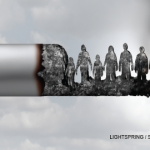
New York, 1960. Don Draper is facing a major dilemma. As creative director of the Sterling Cooper advertising agency, Draper must devise a strategy to sell cigarettes to an increasingly skeptical public concerned about the health risks of cigarettes. The release of the game-changing U.S. Surgeon General’s report, the first serious compilation of data to link smoking with cancer, was still years away. But Draper is growing frantic. He quickly rejects the suggestion made by his tobacco company client that some people might be drawn to smoking despite its health risks because of their urge to live dangerously. There must be a catchphrase that would highlight his client’s product while utterly disregarding the murmurings about smoking’s hazards. Then the jingle hits him: “It’s toasted!” referring to heat curing rather than sun drying of the tobacco leaf.
In fact, this clever slogan was shrewdly used for years by the American Tobacco Company to peddle its Lucky Strike brand. Ostensibly, toasting removed “harmful corrosive acids and sterilized the tobacco,” though in reality, it accomplished very little.1
Courting Doctors
Cigarette advertising played a prominent role in shaping American cultural mores and habits, as witnessed through the eyes of Draper and his co-workers on the critically acclaimed television series, Mad Men. Marketing campaigns were often based on pseudoscience. For decades, tobacco advertising consistently spouted hollow claims to hawk their deadly products. It’s astonishing to discover the complicity of the medical establishment in some of this egregious behavior.
A case in point was the marketing of Philip Morris cigarettes. After their manufacture, the tobacco in cigarettes gradually loses moisture, and the product becomes stale. All manufacturers add hygroscopic agents to help cigarettes retain moisture. In 1930, although glycerin was the preferred agent, Philip Morris used diethylene glycol instead. Despite the lack of any evidence, their marketing team decided to make this difference the central tenet of their advertising claims.2 They sought out Frederick Flinn, PhD, a faculty member at Columbia University in New York City, to produce supportive evidence. A controversial toxicologist, Flinn was best known for having served as an expert witness in the defense of watch manufacturers against claims that radium dial painters suffered ill effects from radiation toxicity. His made-to-order research concluded that irritation from diethylene glycol-treated cigarettes produced throat inflammation of less severity and shorter duration when compared with those moistened with glycerol.3 Full-page advertisements citing his “scholarly,” peer-reviewed publication appeared repeatedly in major medical journals, including the Journal of the American Medical Association. By emphasizing that doctors had scientific evidence to support the superiority of one particular brand of cigarettes, advertisers correctly assumed that sales would soar.



